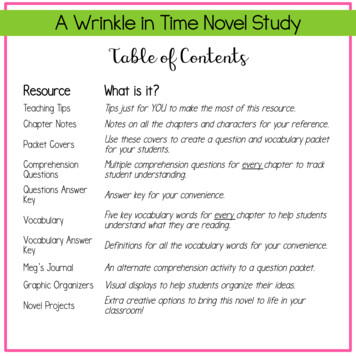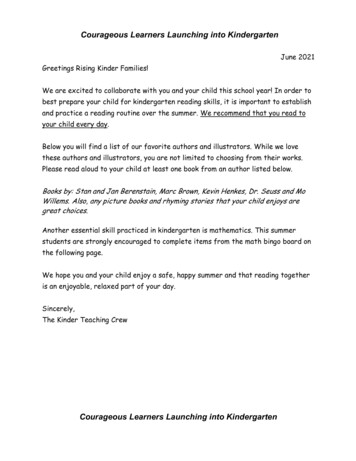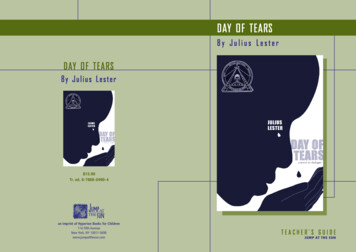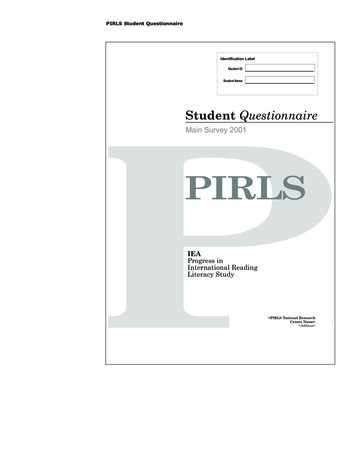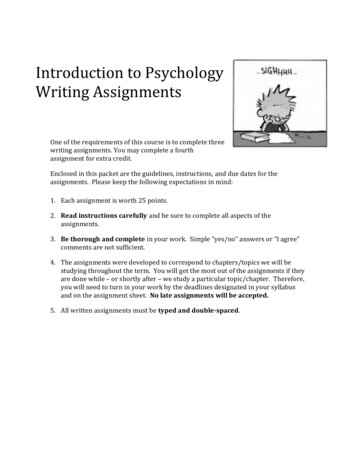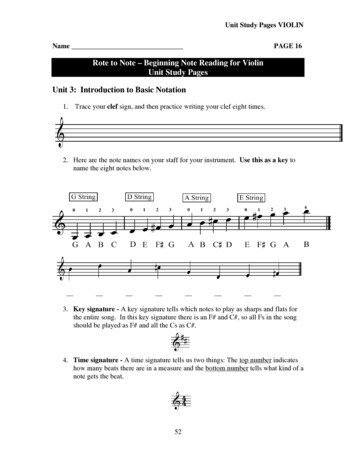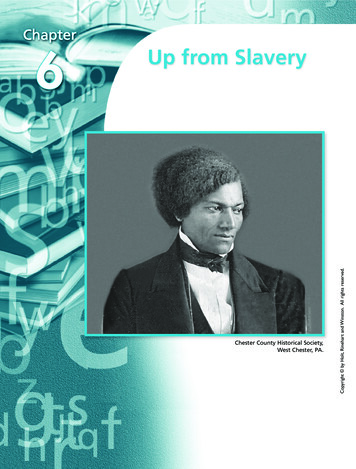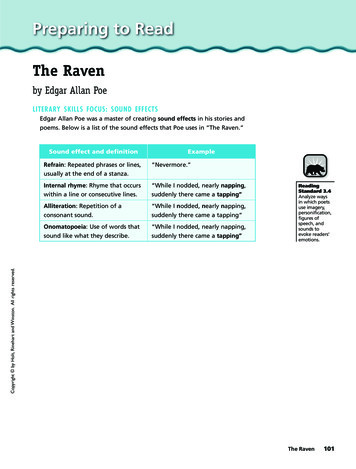
Transcription
Preparing to ReadThe Ravenby Edgar Allan PoeLITERARY SKILLS FOCUS: SOUND EFFECTSEdgar Allan Poe was a master of creating sound effects in his stories andpoems. Below is a list of the sound effects that Poe uses in “The Raven.”Sound effect and definitionExample“Nevermore.”Internal rhyme: Rhyme that occurswithin a line or consecutive lines.“While I nodded, nearly napping,suddenly there came a tapping”Alliteration: Repetition of aconsonant sound.“While I nodded, nearly napping,suddenly there came a tapping”Onomatopoeia: Use of words thatsound like what they describe.“While I nodded, nearly napping,suddenly there came a tapping”ReadingStandard 3.4Analyze waysin which poetsuse imagery,personification,figures ofspeech, andsounds toevoke readers’emotions.Copyright by Holt, Rinehart and Winston. All rights reserved.Refrain: Repeated phrases or lines,usually at the end of a stanza.The Raven101
Preparing to ReadThe RavenREADING SKILLS FOCUS: INTERPRETING MEANING THROUGH ORAL READINGTo enjoy Poe, and to be sure you understand the meaning of each line of thisfamous poem, read the poem aloud or listen to an oral reading. Feel the beat ofthe lines and listen for the rhyming sounds, the repeated consonant sounds, andthe use of onomatopoeia. After you have read the poem aloud or heard it readaloud at least once, you should find that your understanding of the text hasimproved. As you read or listen, bear in mind that literary sound effects—just likemovie sound effects—have a purpose. Think about what Poe is trying to accomplish with the sound effects he uses in the “The Raven.”The chart below provides one example of finding more depth and meaning in apoem by interpreting its sound devices.Interpretation of sound effectLine 13: “The silken, sad, uncertainrustling of each purple curtain”The repetition of the “s” sound(alliteration) echoes the sound thatsilken curtains would make whenrustling in the wind.Copyright by Holt, Rinehart and Winston. All rights reserved.Text102The Raven
The Ravenby Edgar Allan PoeOnce upon a midnight dreary, while I pondered, weak andweary,AOver many a quaint and curious volume of forgotten lore—While I nodded, nearly napping, suddenly there came a tapping,As of someone gently rapping, rapping at my chamber door—5“ ’Tis some visitor,” I muttered, “tapping at my chamberdoor — AOnly this and nothing more.”LANGUAGE COACHTapping and rapping areexamples of onomatopoeia,which is a word that soundslike what it describes. Buzzand quack are also examples.Think of three other examples ofonomatopoeia and writethem below.Ah, distinctly I remember it was in the bleak December;And each separate dying ember wrought its ghost upon thefloor.Eagerly I wished the morrow;—vainly I had sought to borrow10From my books surcease1 of sorrow—sorrow for the lostLenore—Copyright by Holt, Rinehart and Winston. All rights reserved.For the rare and radiant maiden whom the angels name Lenore—BLITERARY FOCUSCircle the internal rhymes inthis stanza.Nameless here for evermore. BCAnd the silken, sad, uncertain rustling of each purple curtainThrilled me—filled me with fantastic terrors never felt before;15So that now, to still the beating of my heart, I stood repeatingREADING FOCUSWith a partner, take turnsperforming an oral readingof this stanza. Which soundeffects most come to life foryou this way?“ ’Tis some visitor entreating2 entrance at my chamber door—Some late visitor entreating entrance at my chamber door;—This it is and nothing more.” CPresently my soul grew stronger; hesitating then no longer,20“Sir,” said I, “or Madam, truly your forgiveness I implore;3But the fact is I was napping, and so gently you came rapping,And so faintly you came tapping, tapping at my chamber door,1.2.3.surcease: end.entreating: begging; asking.implore: plead; ask.The Raven103
That I scarce was sure I heard you”—here I opened wide theAdoor;—LITERARY FOCUSDarkness there and nothing more.Underline the alliteration inline 26.25BDeep into that darkness peering, long I stood there wondering,LITERARY ANALYSISfearing,What does the speakersay might be causing thetapping? Do you thinkhe really believes his ownexplanation? Why or whynot?Doubting, dreaming dreams no mortal ever dared to dreambefore; ABut the silence was unbroken, and the stillness gave no token,And the only word there spoken was the whispered word,“Lenore?”This I whispered, and an echo murmured back the word,“Lenore!”Merely this and nothing more.30Back into the chamber turning, all my soul within me burning,Soon again I heard a tapping somewhat louder than before.“Surely,” said I, “surely that is something at my window lattice;4Let me see, then, what thereat is, and this mystery explore—35Let my heart be still a moment and this mystery explore;—Open here I flung the shutter, when, with many a flirt andflutter,In there stepped a stately Raven of the saintly days of yore;5Not the least obeisance6 made he; not a minute stopped orCQUICK CHECKWho or what enters thespeaker’s chamber?stayed he;40But, with mien7 of lord or lady, perched above my chamberdoor— C4.5.6.7.104The Ravenlattice: shutter or screen formed by strips or bars overlaid in acrisscross pattern.Raven . . . of yore: Of yore is an obsolete way of saying “of time longpast.” Poe’s allusion is to 1 Kings 17:1-6, which tells of the prophetElijah being fed by ravens in the wilderness.obeisance (OH BAY SIHNS): gesture of respect.mien (MEEN): manner.Copyright by Holt, Rinehart and Winston. All rights reserved.’Tis the wind and nothing more!” B
Perched upon a bust of Pallas8 just above my chamber door—Perched, and sat, and nothing more.Then this ebony birdbeguiling9my sad fancy into smiling,By the grave and stern decorum of the countenance it wore,45“Though thy crest be shorn and shaven, thou,” I said, “art sureno craven,DREADING FOCUSFirst, use a dictionary to lookup any unfamiliar words inthis stanza. Then, read thisstanza aloud. How doesknowing the meanings of thewords in this stanza affectyour oral reading of it?Ghastly grim and ancient Raven wandering from the Nightlyshore—Tell me what thy lordly name is on the Night’s Plutonian shore!”10Quoth the Raven “Nevermore.” DMuch I marveled this ungainly11 fowl to hear discourse so plainly,50Though its answer little meaning—little relevancy bore;For we cannot help agreeing that no living human beingEver yet was blessed with seeing bird above his chamber door—Bird or beast upon the sculptured bust above his chamber door,With such name as “Nevermore.”55But the Raven, sitting lonely on the placid bust, spoke onlyCopyright by Holt, Rinehart and Winston. All rights reserved.That one word, as if his soul in that one word he did outpour.Nothing farther then he uttered—not a feather then he fluttered—Till I scarcely more than muttered “Other friends have flownbefore—On the morrow he will leave me, as my Hopes have flown before.”Then the bird said “Nevermore.”60Startled at the stillness broken by reply so aptly spoken,“Doubtless,” said I, “what it utters is its only stock and storeCaught from some unhappy master whom unmercifulDisasterFollowed fast and followed faster till his songs one burden bore—8. Pallas: Pallas Athena, the Greek goddess of wisdom.9. beguiling (BIH GY LIHNG): deceiving.10. Plutonian shore: Pluto is the Greek god of the underworld–the landof darkness—called Hades (HAY DEEZ). Hades is separated from theworld of the living by several rivers; hence, the mention of a shore.11. ungainly: unattractive.The Raven105
AQUICK CHECK IT Stock Free/JupiterimagesHow does the speakerexplain the bird’s ability tosay “Nevermore”?65Till the dirges of his Hope that melancholy burden boreOf ‘Never—nevermore.’ ” ABut the Raven still beguiling my sad fancy into smiling,Straight I wheeled a cushioned seat in front of bird, and bustLITERARY FOCUSUnderline the internal rhymein this line.Cand door;Then, upon the velvet sinking, I betook myself to linking B70What this grim, ungainly, ghastly, gaunt, and ominous bird ofVOCABULARYyoreWord StudyA censer is a container inwhich incense is burned,usually during religiousservices. What is ahomophone (a word thatsounds the same but hasa different meaning andspelling) of censer? What isthe meaning of this word?Fancy unto fancy, thinking what this ominous bird of yore—Meant in croaking “Nevermore.”This I sat engaged in guessing, but no syllable expressingTo the fowl whose fiery eyes now burned into my bosom’s core;75This and more I sat divining,12 with my head at ease recliningOn the cushion’s velvet lining that the lamplight gloated o’er,But whose velvet-violet lining with the lamplight gloating o’er,She shall press, ah, nevermore!Then, methought, the air grew denser, perfumed from anunseen censer C80Swung by seraphim13 whose footfalls tinkled on the tufted floor.“Wretch,” I cried, “thy God hath lent thee—by these angels hehath sent thee12. divining: guessing; supposing.13. seraphim: highest of the nine ranks of angels.106The RavenCopyright by Holt, Rinehart and Winston. All rights reserved.B
Respite—respite and nepenthe14 from thy memories of Lenore;Quaff,15 oh quaff this kind nepenthe and forget this lostLenore!”Quoth the Raven “Nevermore.”85“Prophet!” said I, “thing of evil!—prophet still, if bird or devil!—Whether Tempter sent, or whether tempest tossed thee hereDREADING FOCUSRead this stanza aloud. Takecareful note of how the linesare punctuated and whatsounds are repeated in youroral reading. How would youdescribe the speaker’s stateof mind here?ashore,Desolate yet all undaunted,16 on this desert land enchanted—On this home by Horror haunted—tell me truly, I implore—Is there—is there balm in Gilead?17—tell me—tell me, I implore!”Quoth the Raven “Nevermore.” D90“Prophet!” said I, “thing of evil!—prophet still, if bird or devil!By that Heaven that bends above us—by that God we bothadore—Tell this soul with sorrow laden if, within the distant Aidenn,18It shall clasp a sainted maiden whom the angels name Lenore—95Clasp a rare and radiant maiden whom the angels nameLenore.”Copyright by Holt, Rinehart and Winston. All rights reserved.Quoth the Raven “Nevermore.” EEQUICK CHECKIn your own words, restatethe request the speakermakes to the Raven in thisstanza. How does the Ravenrespond?“Be that word our sign of parting, bird or fiend!” I shrieked,upstarting—“Get thee back into the tempest and the Night’s Plutonian shore!Leave no black plume as a token of that lie thy soul hath spoken!100Leave my loneliness unbroken!—quit the bust above my door!Take thy beak from out my heart, and take thy form from off mydoor!”Quoth the Raven “Nevermore.”14. nepenthe (NIH PEHN THEE): sleeping potion that people once believedwould relieve pain and sorrow.15. quaff: drink heartily.16. undaunted: unafraid.17. Is . . . Gilead: literally, “Is there any relief from my sorrow?” Poeparaphrases a line from Jeremiah 8:22: “Is there no balm inGilead?” Gilead was a region in ancient Palestine known forits healing herbs, such as balm, a healing ointment.18. Aidenn: Arabic for “Eden; Heaven.”The Raven107
And the Raven, never flitting, still is sitting, still is sittingAOn the pallid19 bust of Pallas just above my chamber door;VOCABULARYAcademic VocabularyAnd his eyes have all the seeming of a demon’s that is dreaming,And the lamplight o’er him streaming throws his shadow on thefloor;And my soul from out that shadow that lies floating on the floorShall be lifted—nevermore! ACopyright by Holt, Rinehart and Winston. All rights reserved.Using details from the text,describe how the mood ofthe poem transforms, orchanges, from the beginningto the end.10519. pallid: pale.108The Raven
Skills PracticeThe RavenUSE A CONCEPT MAPDIRECTIONS: Use the concept map below to create a record of the soundeffects used in “The Raven.” Select one kind of sound effect—refrain, internal rhyme, alliteration, or onomatopoeia—and write it in the center oval. Ineach of the four surrounding ovals, write one example of the sound effect youchose from “The Raven.”Copyright by Holt, Rinehart and Winston. All rights reserved.Sound effect:The Raven109
Applying Your SkillsThe RavenLITERARY SKILLS FOCUS: SOUND EFFECTSDIRECTIONS: Read the following lines from “The Raven.” In the secondcolumn, identify any examples of internal rhyme, alliteration, onomatopoeia,or refrain in the lines given. Remember that a line may have more than onekind of sound effect.Type of sound effect“Meant in croaking ‘Nevermore.’”(line 72)1.“Doubting, dreaming dreamsno mortal ever dared to dreambefore;” (line 26)2.“But the Raven still beguiling mysad fancy into smiling,” (line 67)3.READING SKILLS FOCUS: INTERPRETING MEANING THROUGHORAL READINGDIRECTIONS: Read the poem “The Raven” aloud. Write a paragraph explaininghow an oral reading enhances the effect of the poem.ReadingStandard 3.4Analyze waysin which poetsuse imagery,personification,figures ofspeech, andsounds toevoke readers’emotions.110The RavenCopyright by Holt, Rinehart and Winston. All rights reserved.Line from “The Raven”
LITERARY SKILLS FOCUS: SOUND EFFECTS Edgar Allan Poe was a master of creating sound effects in his stories and poems. Below is a list of the sound effects that Poe uses in "The Raven." Sound effect and definition Example Refrain: Repeated phrases or lines, usually at the end of a stanza. "Nevermore." Internal rhyme: Rhyme that occurs
